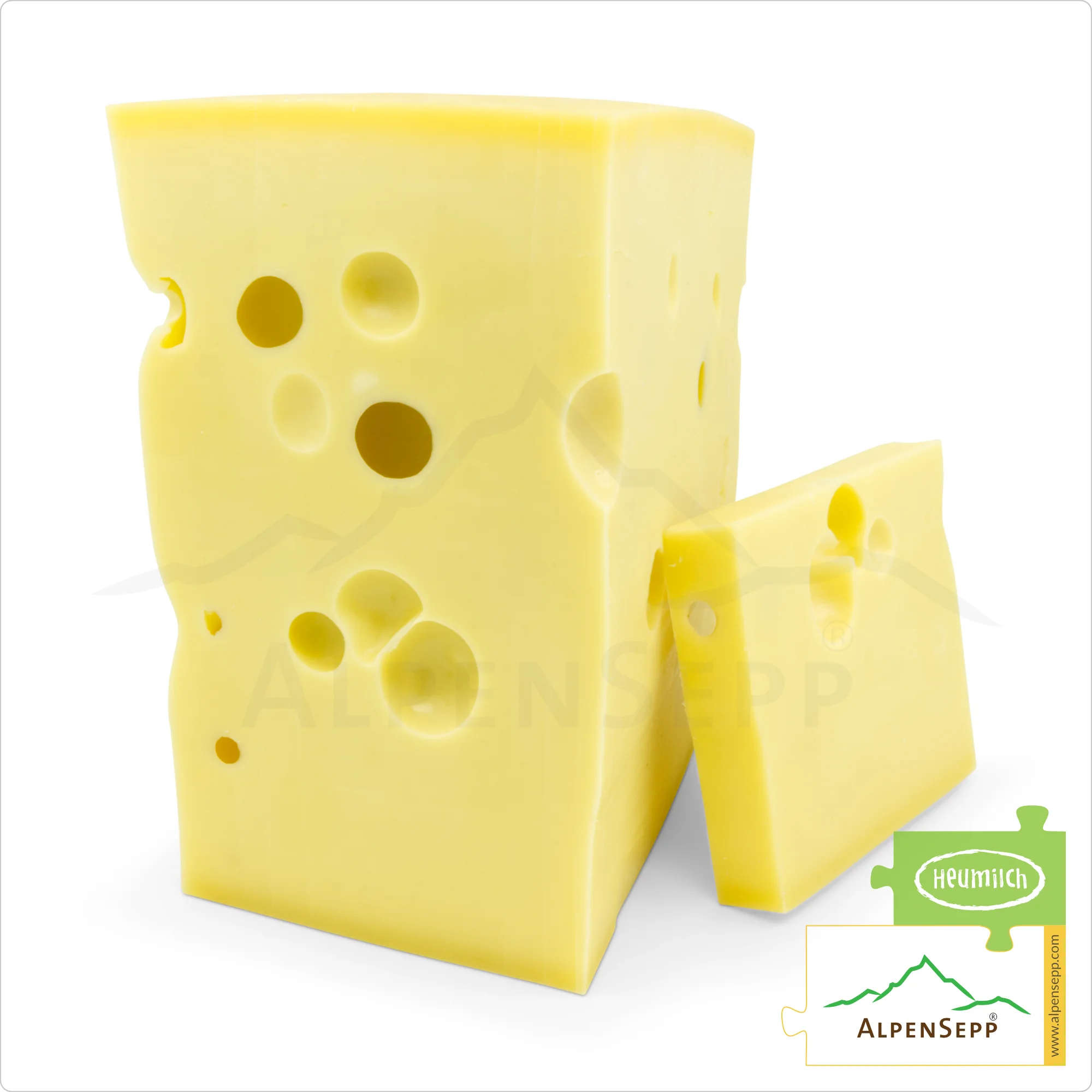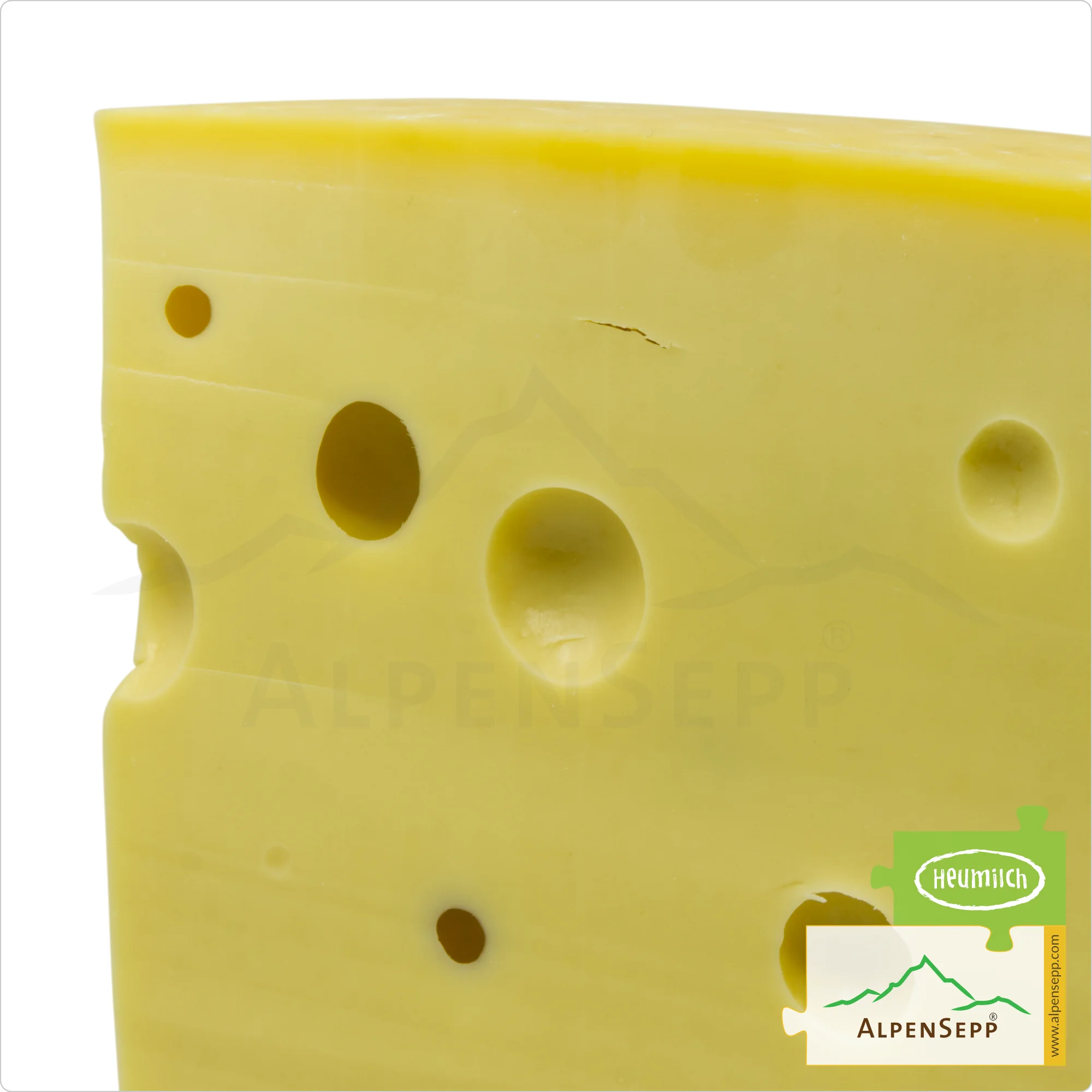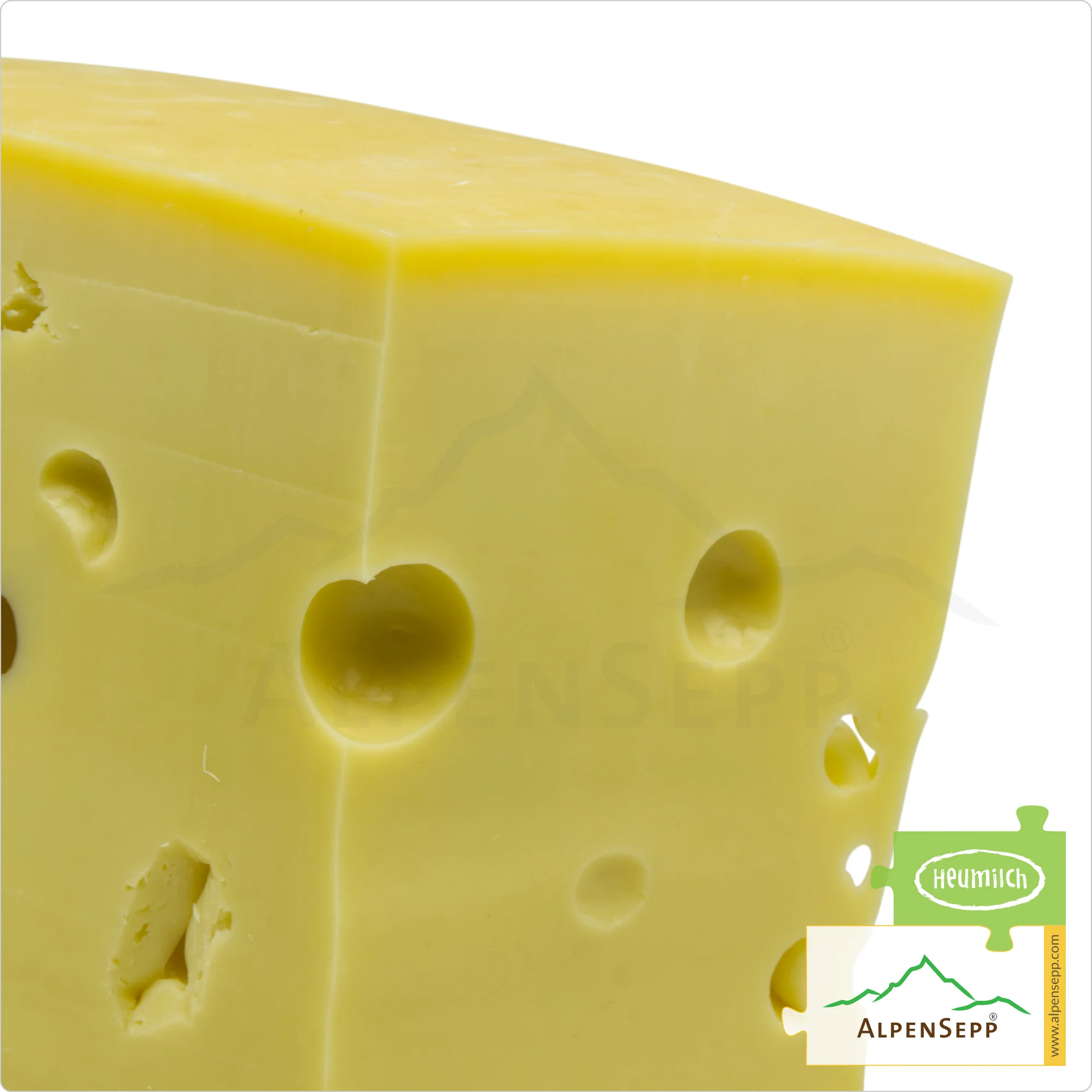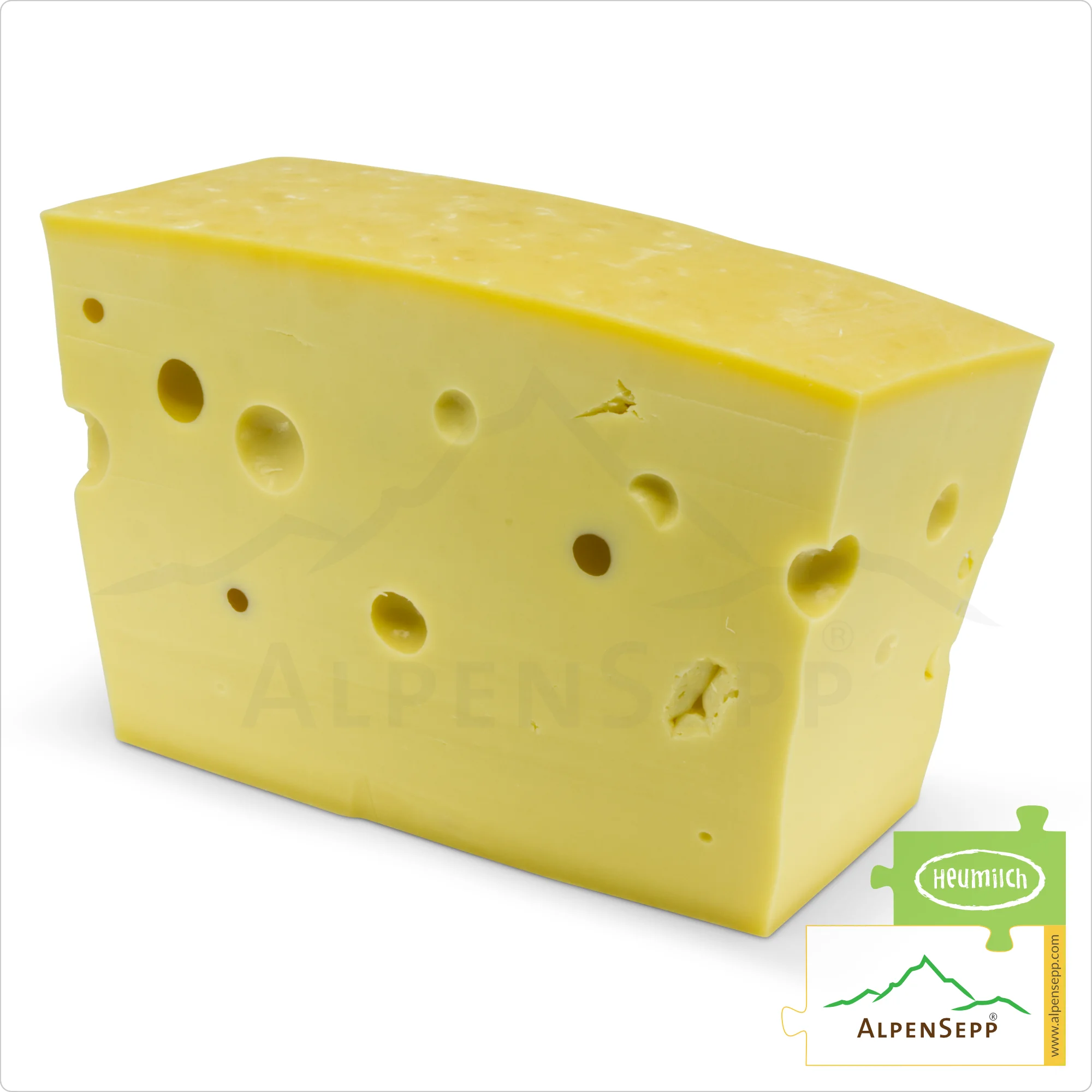Hard cheese | Mountain cheese
Semi-hard cheese

Original price was: € 164,34.€ 147,91Current price is: € 147,91. (incl. VAT)
Heumilch Emmental Cheese Block – 6 kg
Base price: € 27,39/kg
Just imagine experiencing the pure pleasure as you take a bite of the premiumHere in Austria, we call our fresh, natural milk for our cheese production hay milk (hay mild standard) - in Germany it is different. » More info Emmental cheese from the Bregenzerwald. This cheese, with its mild, nutty flavor and unparalleled alpine cheese qualityDetecting cheese defects and quality - on the cheese dough. Recognizing cheese defects requires some practice. » More info, invites you to indulge yourself.
Discover how each slice of this extraordinary cheese takes you on a journey starting with the best hay milkHay milk comes from cows that are fed exclusively with fresh grassland feed, hay and little grain. » More info. This milkCheese milk is the milk intended for the production of cheese, also with the concomitant use of buttermilk products, cream products, sweet whey, sour whey and whey cream (whey cream) » More info comes from cows living in harmony with nature, fed on fresh grass and fragrant hay. Feel how the natural, full-bodied taste of Emmental envelops your senses, a flavor shaped by sustainable and eco-friendly origins.
Every bite tells a story of years of experience and artisanal care. Imagine how the massive wheels are carefully tended and aged in the cheese dairy to achieve the highest quality.
As you delve into this Emmental cheese, you will experience how it develops its mild, sweet, nutty character after three months of ripening, enchanting cheese lovers. And if you dare to wait even longer, you’ll discover an intensely spicy flavor after four months that makes your taste buds dance.
The best part? This Emmental is lactose-free. Enjoy it joyfully and worry-free as the lactic acid bacteriaBacterium Linens (red culture bacteria) are brushed with salt water on the cheese. » More info break down the natural milk sugar, resulting in an intense aroma and unique taste.
When you hold this premium Emmental cheese from the Bregenzerwal in your hands, you are holding more than just cheese – you are holding a masterpiece crafted with love, patience, and the art of cheesemaking. Let yourself be pampered by this exquisite cheese and experience the best that the Alps have to offer.
The massive wheels weighing approximately 80 kg with large holes give this hard cheeseThe Vorarlberger Bergkäse (mountain cheese) is a regional cheese specialty from the Austrian province Vorarlberg. » More info its typical, recognizable appearance. During the ripening process, the wheels are stored at 22 °C and turned frequently. This is the only way for the beautiful, large holes to form and the sweet, hearty, nutty aroma to develop.
While in the Vorarlberg region of the Bregenzerwal alpine area, silage-freeHealthy hay milk comes from cows that are fed exclusively on fresh grassland feed, hay and grain. » More info raw milkThe cheese is made from fresh milk, which was not treated at the beginning of the cheese making process (raw milk). It is almost as it comes from the cow's udder. » More info (so-called hay milk) must be used, other countries also use thermally treated (pasteurized) milk for cheese production. About 12 liters of milk are required for one kilogram of Emmental.
Our Emmental cheese is part of the spicy cheese selection in our shop.
This fine cheese specialty is traditionally made from freshly harvested hay milk following a special recipe and lovingly cared for during the 10-week ripening periodThe milk period is also called the lactation period. It is the time when farm animals such as cows, sheep or goats keep milk for milk production. » More info. Only then does it taste as sophisticated palates prefer.
The secret of the cheese: The distinctive characteristics of Bregenzerwald Emmental are heavily influenced by the high-quality alpine milk, its nutrients, flavor, texture, and the Vorarlberg alpine flora, which result in the unique quality of alpine cheese.
Traditional explanation for the large cheese holes: Through natural fermentation (fermentation by propionic acid bacteria that bind to the fat contentThe F.D.M. value related to dry matter, also depending on the water content of the cheese. The higher the water content (the more watery the cheese) the less dry matter and the less fat the cheese contains. » More info of the hay milk), carbon dioxide gas is produced, which collects in various spots within the cheese without being able to escape.
These spots form the famous holes in the cheeseThe large round holes (round holes, fermentation holes) are caused by fermentation gases of bacteria (for example, the propionic acid bacteria in Emmentaler, etc.). » More info wheel.

The latest Swiss study on “holes in cheese” reveals something surprising – and it has to do with hay.
The shape of the holes can be an indicator of the quality of ripening. If the Emmental holes are not round but extremely oval and alternately very small or large, it can indicate improper ripening.
Such improperly ripened Emmental often tastes bitter or unpleasant. More intriguing details about Emmental can be found on Wikipedia.

The Emmental cheese is famous for its large holes and distinctive aroma. The characteristic holes of Emmental cheese develop during the ripening process.

Natural, firm, golden yellow, with the cheese dairy mark on one side of the wheel. With increasing age, it becomes darker, and for cave-ripened Emmental, it can develop a dark brown to black patina.

The Emmental cheese wheels, made from hay raw milk, are stored by hand during ripening at 22°C and turned frequently. This process can last up to 18 months or longer. The longer the Emmental is aged, the stronger its aroma becomes.
The uniqueness of Emmental cheese lies in its nutty, aromatic, special cheese flavor.
Emmental Intensity
How mild or tangy is the cheese? We define it on a scale of 0 (mild) to 10 (tangy).
Emmental Texture
How firm is the cheese? We define it on a scale of 0 (soft) to 10 (hard).
Emmental Ripening Time
How long is the cheese aged? We define the ripening period between 1 and 12 months.
| Milk: | 100% from silage-free hay milk |
| Cheese Type: | Lactose-free hard cheese (HK) |
| Ripening Method: | Propionic acid fermentation in a heated cellarThe alpine cheese is best located in a cellar with high humidity. » More info |
| Flavor Profile: | Mild and full-bodied |
| Ripening Duration: | 4 months |
| Fat in Dry MatterThe dry matter refers to that portion of the cheese that remains after removal of the water contained. The more water is removed from the cheese, the lower its dry matter and vice versa. » More info: | Minimum 45% |
| Absolute Fat: | Approximately 30% |
| Allergens: | Contains only milk components, no other allergenic potential |
| LactosePeople with lactose intolerance can not or only insufficiently digest milk sugar (lactose or lactose). » More info: | Not present |
| RennetNatural rennet is a mixture of the enzymes chymosin and pepsin, which is obtained from the abomasum of young ruminants in milk-drinking age. » More info: | Natural, animal-derived rennet |
| Salt: | Iodine-free table salt |
| What defines the cheese’s character? | In the Vorarlberg Bregenzerwald, silage-free raw milk (hay milk) must be used, whereas in other countries thermally treated (pasteurized) milk is often employed. About 12 liters of milk are required to produce one kilogram of Emmental. |
| How does the cheese taste? | Lightly sweet with a walnut-like aroma. |
| What is its texture like? | Smooth, “stretchy” cheese texture; firm and melt-in-your-mouth. |
| What is the color of Emmental cheese? | The Emmental rind is naturally firm and golden-yellow. It darkens with age. |
| What is the aroma of the cheese? |
|
| What do the holes look like? | Large, characteristic holes with a shiny surface. |
| Best ways to enjoy the cheese? | Perfect for sandwiches, a delicious cheese mix for Käsknöpfle (cheese dumplings), for gratinating, or versatile for various dishes. |
| How can improper ripening be identified? |
|
If you want to store large pieces of the cheese wheel for more than 2-3 weeks, we recommend using a tea towel.
Use a clean tea towel, soak it in saltwater (add a bit of salt), wring it out, and wrap the cheese with the damp towel. Repeat this process every 2-3 days for optimal results.
If the cheese develops a slight white coating or spots, this is usually due to salt or proteinCasein is a constituent of the protein (protein) of cow's milk, which is obtained for cheese production. » More info crystallizing because of temperature differences. Simply wipe these areas clean.
While aluminum foil can be used (though we don’t recommend it), ensure it has many small holes to allow air circulation.
Never store or cut cheese on boards, wood, or surfaces that previously held bread. Yeast residues from bread can cause the cheese to moldMold cultures are aroma-forming noble molds that grow on the surface (white noble mold) or inside a cheese (blue and green mold). » More info quickly.
| Weight | 6,0 kg |
|---|---|
| Cheese maturing time | 3 months |
| Brand | AlpenSepp® |
| Country of origin | Austria |
| Ingredients | Cow's milk, cheese-making, natural lab, iodine-free table salt |
| Kind of cheese | |
| Name of cheese | Emmental cheese |
| Type of cheese | Traditionally hand-made Austrian semi-hard cheese from silage-free raw milk (hay milk) |
| GTIN | 9120022282183 |
| TARIC | 04069013 |

When you visit any web site, it may store or retrieve information on your browser, mostly in the form of cookies. Control your personal Cookie Services here.
Reviews
There are no reviews yet